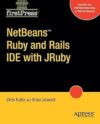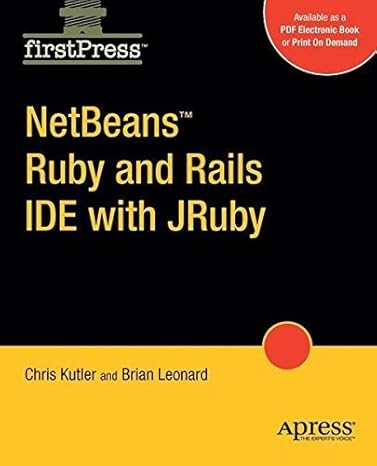
NetBeans Ruby And Rails IDE With JRuby By Chris Kutler Price comparison
NetBeans Ruby And Rails IDE With JRuby By Chris Kutler Price History
NetBeans Ruby And Rails IDE With JRuby By Chris Kutler Description
Discover the Power of the NetBeans Ruby and Rails IDE with JRuby
The NetBeans Ruby and Rails IDE with JRuby, crafted by Chris Kutler, is the ultimate development environment for Ruby on Rails enthusiasts. This robust IDE streamlines your programming tasks, making it easier to write, test, and debug your Ruby applications. With its user-friendly interface and powerful features, you can build dynamic web applications efficiently. Whether you’re a beginner or an experienced developer, this IDE will enhance your coding experience.
Key Features and Benefits of NetBeans Ruby and Rails IDE
- Integrated JRuby Support: Easily work with JRuby, which allows you to run Ruby applications on the Java Virtual Machine (JVM). This feature provides seamless integration with Java libraries, boosting your project’s capabilities.
- Code Editor with Smart Editing: Enjoy advanced code editing with syntax highlighting, code completion, and intelligent refactoring tools. This ensures faster development cycles and reduces the likelihood of syntax errors.
- Built-in Debugging Tools: The IDE’s powerful debugging environment allows you to set breakpoints and inspect variables. Debug Ruby applications with ease to enhance the quality of your software.
- Version Control Integration: Keep your projects organized with Git and Mercurial support. Collaborate with other developers effectively and manage your version history seamlessly.
- Project Templates: Start new projects quickly using pre-configured templates optimized for Ruby on Rails applications. This feature accelerates the setup process, allowing you to focus on coding rather than configuration.
- Rich Plugin Ecosystem: The NetBeans platform supports a variety of plugins that expand its capabilities. Customize your development environment based on your specific needs.
Price Comparison Across Different Suppliers
The pricing for the NetBeans Ruby and Rails IDE with JRuby varies amongst different suppliers. Our site allows you to compare prices from various retailers, ensuring that you find the best deal. Over the past six months, prices have fluctuated, showcasing trends that could help you decide when to purchase. We recommend checking regularly as prices can drop dramatically during sales or promotional events.
Notable Trends from the 6-Month Price History
Examining the 6-month price history chart, we have observed noteworthy trends. Prices reached their peak during the holiday season but have shown a steady decline as new updates and versions have been released. Buyers are currently benefiting from discounts, making it an excellent time to invest in this powerful IDE.
Customer Reviews and Feedback
Users have shared their experiences with the NetBeans Ruby and Rails IDE, highlighting numerous advantages as well as a few drawbacks. On the positive side, many reviewers appreciate the intuitive interface and robust debugging tools that significantly enhance productivity. Customers also note that the integration with JRuby expands functionality and allows mixing Ruby with Java, perfect for diverse applications.
However, some users have mentioned that the initial setup might be slightly complicated for beginners unfamiliar with development environments. A few have also pointed out that occasional performance lags can occur when handling larger projects. Overall, the benefits outweigh the drawbacks, making this IDE a favorite among many developers.
Explore Unboxing and Review Videos to Learn More
If you’re curious about the NetBeans Ruby and Rails IDE with JRuby, consider watching some unboxing and review videos available on YouTube. These videos provide real-world insights, showcasing the IDE’s features in action and offering tips from experienced users. They can help you understand the software’s potential and how it can fit into your development workflow.
Utilize the power of the NetBeans Ruby and Rails IDE with JRuby to elevate your coding experience. With its comprehensive features and benefits, it’s designed to help you become a more efficient developer. Whether you are looking for Ruby on Rails project management or advanced debugging capabilities, this IDE has you covered.
Don’t miss out on finding the best prices! Compare prices now!
NetBeans Ruby And Rails IDE With JRuby By Chris Kutler Reviews (3)
3 reviews for NetBeans Ruby And Rails IDE With JRuby By Chris Kutler
Only logged in customers who have purchased this product may leave a review.








Amazon Customer –
The book, as a manual, can get dated fast, however it does a good job on getting you started using NetBeans and JRuby fast. It’s usefulness will be a couple of evenings and eventually a few revisits down the line. It does just what it’s meant for.
John Yeary –
I decided to write a quick review on the NetBeans Ruby and Rails IDE with JRuby book from Apress. The book is focused on NetBeans 6.5 and JRuby development. This is not a limitation on the book however. The book is really an introduction to how to use NetBeans to do Ruby development. The latest version of NetBeans (6.8) has a number of additional features (enhancements) over the version detailed in this book. Perhaps the authors can do an up-to-date version of the book to cover the latest enhancements. If not, perhaps I will consider taking up the mantle.
I really loved the book. I would give it 4/5 stars which if you have read my reviews is a brutal rating to get.
I performed a baseline install of NetBeans 6.5 including the plugins required for doing JRuby/Ruby development as noted in the book. The book follows along perfectly with the installer and IDE. I guess you could call this book the reference to the IDE for JRuby/Ruby development.
The first chapter details the installation and configuration of the IDE. The explanation is spot on, but NetBeans is also really to install and configure.
The second chapter covers your basic “Hello World” from both a basic JRuby project and from JRuby on Rails (JRoR).
The third chapter covers configuration of JRuby using the NetBeans gem manager, setting up servers, and configuring databases for use with the development environment. The section on gems with native extensions, and replacements is very helpful.
Chapters four and five cover Ruby and Rails projects in more detail. It demonstrates a number of the capabilities that the IDE. I really like the Rails Console and example of how to use it.
Chapter six covers editing files and the capabilities that the IDE provides including code completion. This was the first real mainstream IDE to provide JRuby/Ruby code completion. It does it beautifully.
Chapter seven covers debugging and testing. The authors do a great job of explaining why NetBeans should be your choice of IDE for doing Ruby development.
JRuby itself is the topic of chapter eight. There is an example of how to use JRuby in Java projects. This is really cool. However, it should be noted that you need to make some changes for it to work on JSE5. This is noted on Page 136, but the code needs a slight modification to use JRubyScriptEngineManager instead of ScriptEngineManager.
Chapter nine covers Ruby on Rails (RoR) deployments using warbler. I have found warbler to be a great tool and use it extensively to deploy applications to GlassFish v 2.x.
Chapter ten is all about the IDE. It shows the user a number of customizations available to make NetBeans customized to your style. This is no small accomplishment. The NetBeans team have made a really great IDE and made it extremely flexible. This flexibility did not sacrifice simplicity. Eclipse is flexible too, but a a severe penalty to ease.
In summary, if you are thinking of trying JRuby, or Ruby development, and you want to give NetBeans a try, this is the book to buy 4/5 stars.
J. P. –
First, what the book is not.
As the other reviewer stated this is not a book to teach you Ruby, nor Ruby on Rails. Thus, you should either already be familiar with those topics, or have another book that covers them.
Also, while the title includes “with JRuby”, the book is not limited to JRuby. The book explains how you can use other runtimes as well. The JRuby specific information in particular is Chapter 8 about integration with Java, and Chapter 9 which describe deploying to Glassfish or Tomcat.
Second, what the book is.
The book is a more-or-less tutorial style tour of NetBeans features for developing Ruby applications. I’m not sufficiently familiar with NetBeans to identify whether the coverage of features was exhaustive, but it seems that many of the key areas of development were covered: db connections, code completion, refactoring tools, running tests, and debugging.
If you have decided to use NetBeans for your Ruby work, then this book will provide you with a short & easy read with plenty of screen shots to get help you get up to speed on how to use the IDE.
Although 6.5 is the current stable version, I went through the book using NetBeans 7.0M1, and generally found everything to work as described in print.